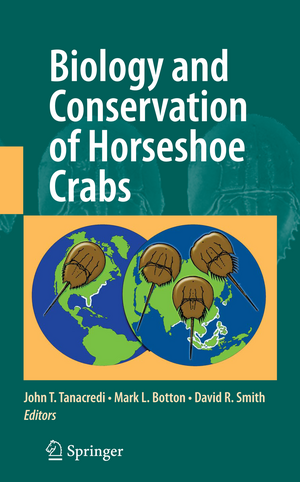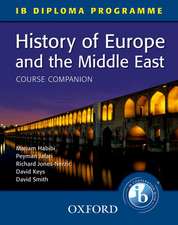Biology and Conservation of Horseshoe Crabs
Editat de John T. Tanacredi, Mark L. Botton, David Smithen Limba Engleză Hardback – 6 iul 2009
| Toate formatele și edițiile | Preț | Express |
|---|---|---|
| Paperback (1) | 1235.43 lei 6-8 săpt. | |
| Springer Us – 23 aug 2016 | 1235.43 lei 6-8 săpt. | |
| Hardback (1) | 1076.12 lei 38-44 zile | |
| Springer Us – 6 iul 2009 | 1076.12 lei 38-44 zile |
Preț: 1076.12 lei
Preț vechi: 1415.96 lei
-24% Nou
Puncte Express: 1614
Preț estimativ în valută:
205.92€ • 215.54$ • 171.39£
205.92€ • 215.54$ • 171.39£
Carte tipărită la comandă
Livrare economică 27 martie-02 aprilie
Preluare comenzi: 021 569.72.76
Specificații
ISBN-13: 9780387899589
ISBN-10: 0387899588
Pagini: 662
Ilustrații: XXVIII, 662 p.
Dimensiuni: 155 x 235 x 41 mm
Greutate: 1.09 kg
Ediția:2009
Editura: Springer Us
Colecția Springer
Locul publicării:New York, NY, United States
ISBN-10: 0387899588
Pagini: 662
Ilustrații: XXVIII, 662 p.
Dimensiuni: 155 x 235 x 41 mm
Greutate: 1.09 kg
Ediția:2009
Editura: Springer Us
Colecția Springer
Locul publicării:New York, NY, United States
Public țintă
Professional/practitionerCuprins
Biology.- Limits on the Global Distribution of Horseshoe Crabs (Limulacea): Lessons Learned from Two Lifetimes of Observations: Asia and America.- Horseshoe Crabs – An Ancient Ancestry Revealed.- The Ecological Importance of Horseshoe Crabs in Estuarine and Coastal Communities: A Review and Speculative Summary.- Relationships Between Sandpipers and Horseshoe Crab in Delaware Bay: A Synthesis.- Horseshoe Crabs, Their Eco-biological Status Along the Northeast Coast of India and the Necessity for Ecological Conservation.- American Horseshoe Crabs, Limulus polyphemus, in Mexico: Open Possibilities.- Basic Habitat Requirements of the Extant Species of Horseshoe Crabs (Limulacea).- The Relationship Between Small- and Large-Scale Movements of Horseshoe Crabs in the Great Bay Estuary and Limulus Behavior in the Laboratory.- Ecology of Horseshoe Crabs in Microtidal Lagoons.- Phylogeography, Demographic History, and Reserves Network of Horseshoe Crab, Tachypleus tridentatus, in the South and East China Seaboards.- Genetic Structure of Japanese Populations of Tachypleus tridentatus by mtDNA AT-Rich Region Sequence Analysis.- Reproductive Competition and Sexual Selection in Horseshoe Crabs.- Vision in Horseshoe Crabs.- Sperm Attachment on the Egg of Malaysian King Crab, Carcinoscorpius rotundicauda.- Distribution and Development of Limulus Egg Clusters on Intertidal Beaches in Delaware Bay.- Comparisons in Prosomal Width and Body Weight Among Early Instar Stages of Malaysian Horseshoe Crabs, Carcinoscorpius rotundicauda and Tachypleus gigas in the Laboratory.- Emergence Behavior of Juvenile Tachypleus tridentatus Under Simulated Tidal Conditions in the Laboratory and at Two Different Sediment Temperatures.- Distribution of Juvenile Horseshoe Crabs in Subtidal Habitats of DelawareBay Using a Suction-Dredge Sampling Device.- Conservation.- History of Horseshoe Crab Harvest on Delaware Bay.- Biomedical Applications of Limulus Amebocyte Lysate.- The Effect of Hemolymph Extraction Volume and Handling Stress on Horseshoe Crab Mortality.- Horseshoe Crabs in Hong Kong: Current Population Status and Human Exploitation.- Comparative Status and Assessment of Limulus polyphemus with Emphasis on the New England and Delaware Bay Populations.- An Integrative Approach to Horseshoe Crab Multiple Use and Sustainability.- Strategies to Conserve and Enhance Sandy Barrier Habitat for Horseshoe Crabs (Limulus polyphemus) on Developed Shorelines in Delaware Bay, United States.- Conservation Program for the Asian Horseshoe Crab Tachypleus tridentatus in Taiwan: Characterizing the Microhabitat of Nursery Grounds and Restoring Spawning Grounds.- The Effects of Water Quality on Horseshoe Crab Embryos and Larvae.- Heavy Metal Concentration in Horseshoe Crab (Carcinoscorpius rotundicauda and Tachypleus gigas) Eggs from Malaysian Coastline.- A Discussion of Horseshoe Crab Management in Five Countries: Taiwan, India, China, United States, and Mexico.- Clinical Evaluation, Common Diseases, and Veterinary Care of the Horseshoe Crab, Limulus polyphemus.- Aquaculture Methods and Early Growth of Juvenile Horseshoe Crabs (Limulus polyphemus).- Larval Culture of Tachypleus gigas and Its Molting Behavior Under Laboratory Conditions.- Diet Composition of Juvenile Horseshoe Crabs: Implications for Growth and Survival of Natural and Cultured Stocks.- Effect of Sediment Type on Growth and Survival of Juvenile Horseshoe Crabs (Tachypleus tridentatus).- The Conservation Network of Horseshoe Crab Tachypleus tridentatus in Taiwan.- The History of Horseshoe Crab Research and Conservation inJapan.- Public Awareness and Community-Based Conservation for the Horseshoe Crab at Saikai National Park in Nagasaki Prefecture, Japan.- Public Participation in Studies on Horseshoe Crab Populations.- Green Eggs and Sand: A Collaborative Effort of Scientists, Teachers, Resource Managers, and Stakeholders in Educating About Limulus polyphemus.- Community Building: An Integrated Approach to Horseshoe Crab Conservation.
Notă biografică
Dr. John T. Tanacredi is Chair and Professor of Earth and Marine Sciences at Dowling College. He is a Research Associate in the Invertebrate Zoology Department at the American Museum of Natural History.
Dr. Mark L. Botton is a Professor of Biology at Fordham University.
Dr. David R. Smith is a Research Biological Statistician for the U.S. Geological Survey.
Dr. Mark L. Botton is a Professor of Biology at Fordham University.
Dr. David R. Smith is a Research Biological Statistician for the U.S. Geological Survey.
Textul de pe ultima copertă
Biology and Conservation of Horseshoe Crabs, edited by Dr. John T. Tanacredi, Dr. Mark L. Botton, and Dr. David R. Smith, offers proceedings from a ground-breaking 2007 international symposium at Dowling College on the science and conservation of the horseshoe crab. Horseshoe crabs are well-known as "living fossils" with a geological history covering hundreds of millions of years and an ancestry reaching back 455 million years to the doorstep of the Cambrian. In spite of this longevity, each species now faces common and growing threats. Loss of essential spawning habitat due to erosion and shoreline development, coastal pollution, and overfishing all threaten horseshoe crab populations. Symposium participants from around the world gathered to share knowledge, present research results, and identify conservation challenges facing horseshoe crabs. This shared international knowledge and experience is presented here as a beginning in our collective efforts to conserve the world’s horseshoe crab species. Throughout the book, the reader will find results of new studies, and authoritative reviews on the science and conservation of all four of the world’s horseshoe crab species.
About the editors:
Dr. John T. Tanacredi is Chair and Professor of Earth and Marine Sciences at Dowling College. He is a Research Associate in the Invertebrate Zoology Department at the American Museum of Natural History.
Dr. Mark L. Botton is a Professor of Biology at Fordham University.
Dr. David R. Smith is a Research Biological Statistician for the U.S. Geological Survey.
About the editors:
Dr. John T. Tanacredi is Chair and Professor of Earth and Marine Sciences at Dowling College. He is a Research Associate in the Invertebrate Zoology Department at the American Museum of Natural History.
Dr. Mark L. Botton is a Professor of Biology at Fordham University.
Dr. David R. Smith is a Research Biological Statistician for the U.S. Geological Survey.
Caracteristici
Presents the latest research on horseshoe crabs Identifies conservation challenges Formulates plans for an international conservation program Includes supplementary material: sn.pub/extras






